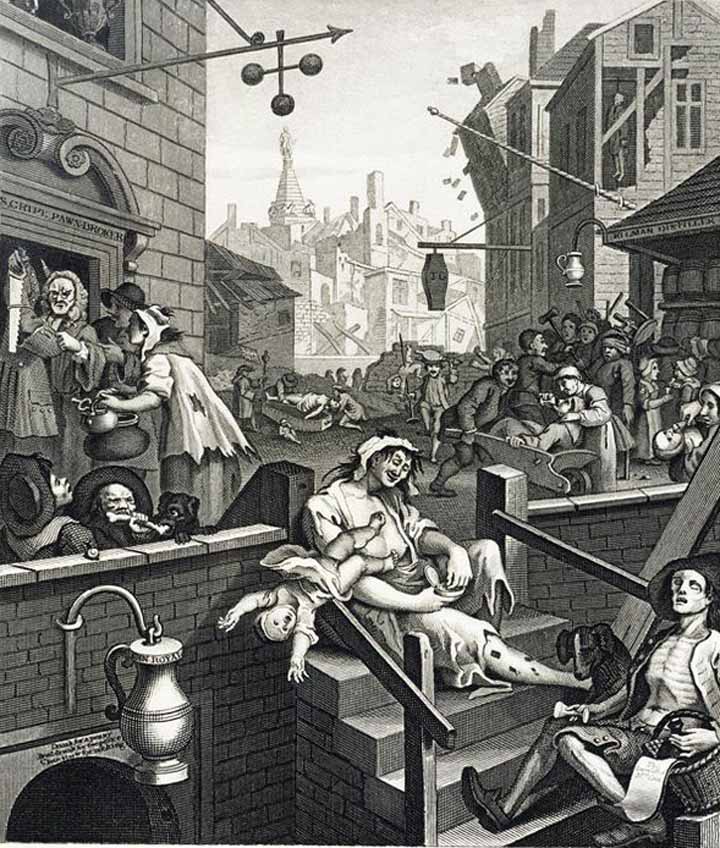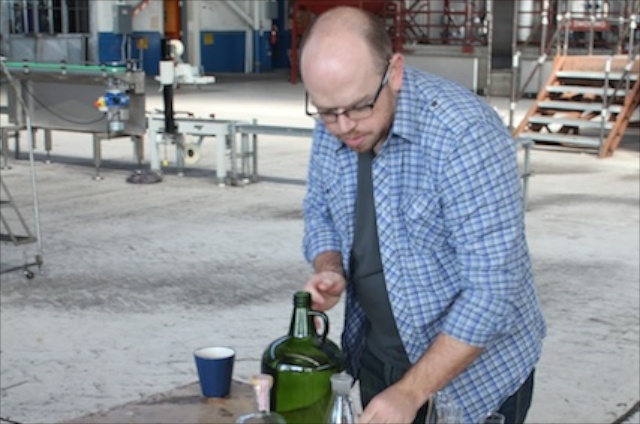Gin Fever: Part II
 William Hogarth's 1751 depiction of London's "Gin Lane"
William Hogarth's 1751 depiction of London's "Gin Lane"
By the 1720s, the streets of London were looking like the Tenderloin on Turk between Gough and Laguna. Gately writes:
Statistics suggested that every man, woman, and child in London knocked back more than a pint of gin per head per week. This alarmingly high level of consumption generated shocking levels of drunkenness in the capital. The problem was aggravated by the squalid living conditions in the slums. Tenement houses were packed from their cellars to their rafters. People dossed down ten to a room, and the only recreation or relief they could afford was drinking gin.
It prevailed into the 1730s. The press had a field day with the drama. Stories of intoxication were abound in the daily news, working like modern day paparazzi presses. The story of gin as a cultural destroyer was too good to pass up. Gin was causing mothers to murder their infants. Infanticide rates were rising. Gin might cause one to die in their sleep. Gin drinkers were seen as bad for capitalism--"they ate less, and they pawned their clothes instead of buying new ones." Anything to garner support for the temperance movement. Much like modern street drugs, gin had acquired a variety of new names like "kill-me-quick," or, my favorite, "strip-me-naked." A new gin act was passed in 1736 with harsher penalties, but it still did little to stem the tide. The next decade was a mess, full of gin-drinking anger, more reforms, rewards for snitches, snitches gettin' their stitches (modern-day street slang for beating down a rat), and more excessive drinking.
Gately writes that:
By 1750, London had been in the thrall of (gin) for a quarter of a century. (It) had been legislated against five times, declared the enemy of religion and health, yet persisted nonetheless. Gin had been a constant in an age of change. However, London in 1750 was no longer the rowdy place it had been at the turn of the century. The threat of rebellion has been countered and suppressed, wars had been won in Europe and elsewhere. The best and cruelest work of the golden age of English satire had been written. In 1751, approximately 7 million gallons of gin were taxed, the following year less than 4.5 million. The fall reflected declining demand and, best of all, the common people responded positively to new legislation, having seemed to have lost the desire to debase themselves.
While gin spurred several decades worth of debauchery in London, like all trends, it eventually calmed down and became less extreme of an intoxicant. Gin would never lose its status in popular drinking culture, however. It played a key role in the cocktails of the Belle Epoche, and the Gatsby-era libations we celebrate now as pre-Prohibition. It carried on into the tropical novels of Hemingway, and the colonial stories of Graham Greene in the Caribbean. It may have taken a back seat in the 1980s, but Snoop Dogg brought it right back with his 1993 gangta-rap anthem "Gin and Juice" ("Now that I got me some Seagram's gin, everybody got their cup, but they ain't chipped in). Along with Bourbon, it's now the biggest mainstay of today's craft cocktail revival.
 St. George's Dave Smith working on our Faultline gin
St. George's Dave Smith working on our Faultline gin
We know of gin's importance to the history of alcohol and our drinking culture, but how is it actually made? To answer this question in detail I decided to call my good friend Dave Smith, distiller for St. George in nearby Alameda, to make sure I had all my facts straight.
David D: I was hoping you could just walk me through how a batch of St. George Terroir gin was made so we could help people reading the blog understand the process. You start with the grain neutral spirit, the GNS, right?
Dave S: Sure, uh....without giving away too many state secrets....the concept of the Terroir gin, and with any project that has multiple components--gin is an example--some producers want to distill all of the ingredients separately and then combine them, which sort of allows you the ultimate level of control. You have the ability to fine tune the flavors and find the ingredients' weight in that blend. We also believe in the integration of these components and their potential for being distilled together. So some of the ingredients for the Terroir gin will actually be distilled together in a 400 gallon pot still with GNS, to which we actually have a steam basket attached through which those vapors travel though. That gives us the option of actually boiling certain ingredients themselves or to steam certain ingredients that will benefit from that process.
David D: Do certain ingredients work better when boiled rather than steamed?
Dave S: Yes, a good example is bay laurel. Bay laurel is going to break down a lot more thoroughly when boiled, it's going to give off a some different flavor compounds aromatically. At the end of the day it's a leaf. It's going to fall apart. If you think about spinach, just as a point of reference--fresh spinach, steamed spinach, and boiled spinach are three uniquely different things. Citrus peels also benefit from boiling as heat helps to open up the pores, it can withstand that boiling, and we can do a better job of capturing the essence of that citrus peel. Bay laurel, not so much. The laurel goes into the steam basket with the juniper berries, so that we can get the aromatic, blueberry components, rather than the resiny, seedy aspects of the berry.
David D: So you're saying that some ingredients in the Terroir are put into the steam basket, while others are boiled?
Dave S: Yes, that's right.
David D: Are you also distilling them in different batches, then marrying them together?
Dave S: Actually, on those ingredients we'll distill them together in the same process because we believe strongly in the value of marrying those components together in the pot still. The still will help break down and capture the most balanced version of these botanical elements. You want to be mindful of how you manage each component, but the ingredients of the Terroir work together. The Douglas fir component, however, isn't something that we can forage for year-round, unlike bay laurel which we can get from Lance's yard. In that case, we have to do that as a separate component. But that helps us to isolate that flavor and control it as we blend it in. Coastal sage is another ingredient we can only get maybe once or twice a year.
David D: What about the coriander?
Dave S: The wok-roasted coriander is another big process. Every 400 gallon batch in the pot still is a an hour and half or two hours of distilling wok-roasted coriander seeds. It brings out almost a citrusy, grapefruit quality of the seeds. You can, however, run into certain botanical ingredients that are so intense that controlling them on a large scale batch, while I want to make sure they're well integrated, the choice is also to actually focus on re-integrating them--to have them out of the main batch and to use them almost like garnish on a plate. We do a separate distillation of citra-hops for Botanivore, and for Douglas fir for the Terroir.
David D: As someone who distills whiskey, fruit brandies, vodka, pretty much everything, where does gin fall in the hierarchy of spirits for you?
Dave S: A lot of people talk about gin, saying things like, "I don't like gin, but I like flavored vodka,"--I've got news for you: gin is flavored vodka.
David D: That's what I said!!
Dave S: That being said, what I would liken gin to actually is absinthe. You know about our time with absinthe and how long we worked with it. The real interesting challenge with absinthe and gin is not only to act as a supply chain manager with your ingredients, finding the best possible products and understanding how to work with them, how to utilize them and work safely with them, but also how to actually balance those ingredients. And if you're choosing not to balance them, then understanding how to do that specifically as a stylistic choice in response to other products on the market--you're looking to stand out.
For us, the dry rye gin is rye whiskey-based with coriander, caraway, black pepper--these are elements that are really focused and dialed in to make something that's a play on a London dry style, but also very malty creating a spirit that's very unique. When you first smell it the rye shows immediately. The black pepper shows later, but there are very few ingredients involved. The Botanivore on the other hand has nineteen specific ingredients, yet comes across as softer and more balanced. The challenge in making gin, and with absinthe, is to make choices and to understand your ingredients as a painter would understand his paints. You have to understand how to layer your colors to make a balanced picture. Or, if making an unbalanced picture, to understand why you're doing so.
David: Wouldn't that be an argument for viewing gin as one of the tougher spirits to produce, rather than seeing it simply as "flavored vodka"?
Dave S: I can see where you're going with that and I think there's a strong argument there, but I hate to say that distilling gin is harder or easier. Sometimes we get caught in that idea that something is better or worse. I don't think there's anything better about a four piece quartet versus a twenty piece orchestra, or even a soloist--a unique beautiful voice. None of these things are better, greater, or harder than another, but their processes are very unique and the challenges that they present are all very different.
-David Driscoll
